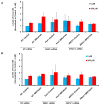BRCA1 and BRCA2 protect against oxidative DNA damage converted into double-strand breaks during DNA replication
- PMID: 25836596
- PMCID: PMC4442488
- DOI: 10.1016/j.dnarep.2015.03.002
BRCA1 and BRCA2 protect against oxidative DNA damage converted into double-strand breaks during DNA replication
Abstract
BRCA1 and BRCA2 mutation carriers are predisposed to develop breast and ovarian cancers, but the reasons for this tissue specificity are unknown. Breast epithelial cells are known to contain elevated levels of oxidative DNA damage, triggered by hormonally driven growth and its effect on cell metabolism. BRCA1- or BRCA2-deficient cells were found to be more sensitive to oxidative stress, modeled by treatment with patho-physiologic concentrations of hydrogen peroxide. Hydrogen peroxide exposure leads to oxidative DNA damage induced DNA double strand breaks (DSB) in BRCA-deficient cells causing them to accumulate in S-phase. In addition, after hydrogen peroxide treatment, BRCA deficient cells showed impaired Rad51 foci which are dependent on an intact BRCA1-BRCA2 pathway. These DSB resulted in an increase in chromatid-type aberrations, which are characteristic for BRCA1 and BRCA2-deficient cells. The most common result of oxidative DNA damage induced processing of S-phase DSB is an interstitial chromatid deletion, but insertions and exchanges were also seen in BRCA deficient cells. Thus, BRCA1 and BRCA2 are essential for the repair of oxidative DNA damage repair intermediates that persist into S-phase and produce DSB. The implication is that oxidative stress plays a role in the etiology of hereditary breast cancer.
Keywords: BRCA; Cancer; Chromosome aberrations; Homologous recombination; Oxidative stress.
Copyright © 2015 Elsevier B.V. All rights reserved.
Conflict of interest statement
Simon Powell have no financial conflicts of interest with any of the work in this submitted paper.
Simon Powell have a single position of employment (Memorial Sloan-Kettering) and no other sources of income.
Figures





Similar articles
-
Therapeutic exploitation of tumor cell defects in homologous recombination.Anticancer Agents Med Chem. 2008 May;8(4):448-60. doi: 10.2174/187152008784220267. Anticancer Agents Med Chem. 2008. PMID: 18473729 Review.
-
BRCA1 regulates RAD51 function in response to DNA damage and suppresses spontaneous sister chromatid replication slippage: implications for sister chromatid cohesion, genome stability, and carcinogenesis.Cancer Res. 2005 Dec 15;65(24):11384-91. doi: 10.1158/0008-5472.CAN-05-2156. Cancer Res. 2005. PMID: 16357146
-
Revisiting the BRCA-pathway through the lens of replication gap suppression: "Gaps determine therapy response in BRCA mutant cancer".DNA Repair (Amst). 2021 Nov;107:103209. doi: 10.1016/j.dnarep.2021.103209. Epub 2021 Aug 13. DNA Repair (Amst). 2021. PMID: 34419699 Free PMC article. Review.
-
DNA damage response markers are differentially expressed in BRCA-mutated breast cancers.Breast Cancer Res Treat. 2015 Feb;150(1):81-90. doi: 10.1007/s10549-015-3306-6. Epub 2015 Feb 19. Breast Cancer Res Treat. 2015. PMID: 25690937 Free PMC article.
-
Homologous repair of DNA damage and tumorigenesis: the BRCA connection.Oncogene. 2002 Dec 16;21(58):8981-93. doi: 10.1038/sj.onc.1206176. Oncogene. 2002. PMID: 12483514 Review.
Cited by
-
Interplay of oxidative stress, cellular communication and signaling pathways in cancer.Cell Commun Signal. 2024 Jan 2;22(1):7. doi: 10.1186/s12964-023-01398-5. Cell Commun Signal. 2024. PMID: 38167159 Free PMC article. Review.
-
Cardiovascular disease risk after breast cancer treatment in patients with a BRCA1/2 pathogenic variant.Breast Cancer Res Treat. 2025 Feb;209(3):573-583. doi: 10.1007/s10549-024-07516-2. Epub 2024 Oct 31. Breast Cancer Res Treat. 2025. PMID: 39482556
-
BReast CAncer susceptibility gene 2 deficiency exacerbates oxidized LDL-induced DNA damage and endothelial apoptosis.Physiol Rep. 2020 Jul;8(13):e14481. doi: 10.14814/phy2.14481. Physiol Rep. 2020. PMID: 32638521 Free PMC article.
-
MRI Background Parenchymal Enhancement Is Not Associated with Breast Cancer.PLoS One. 2016 Jul 5;11(7):e0158573. doi: 10.1371/journal.pone.0158573. eCollection 2016. PLoS One. 2016. PMID: 27379395 Free PMC article.
-
BRCA1 and Breast Cancer: a Review of the Underlying Mechanisms Resulting in the Tissue-Specific Tumorigenesis in Mutation Carriers.J Breast Cancer. 2019 Mar;22(1):1-14. doi: 10.4048/jbc.2019.22.e6. J Breast Cancer. 2019. PMID: 30941229 Free PMC article. Review.
References
-
- McCord JM. Superoxide dismutase in aging and disease: an overview. Methods Enzymol. 2002;349:331–41. - PubMed
-
- Hursting SD, et al. Mechanism-based cancer prevention approaches: targets, examples, and the use of transgenic mice. J Natl Cancer Inst. 1999;91(3):215–25. - PubMed
-
- Lavigne JA, et al. The effects of catechol-O-methyltransferase inhibition on estrogen metabolite and oxidative DNA damage levels in estradiol-treated MCF-7 cells. Cancer Res. 2001;61(20):7488–94. - PubMed
-
- Hamada J, et al. Increased oxidative DNA damage in mammary tumor cells by continuous epidermal growth factor stimulation. J Natl Cancer Inst. 2001;93(3):214–9. - PubMed
Publication types
MeSH terms
Substances
Grants and funding
LinkOut - more resources
Full Text Sources
Other Literature Sources
Research Materials
Miscellaneous

